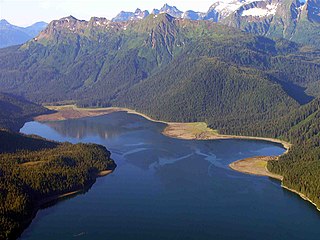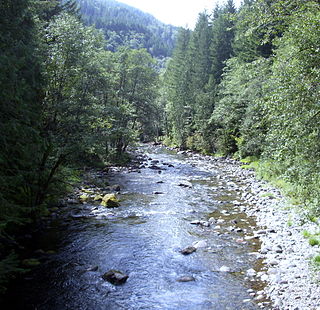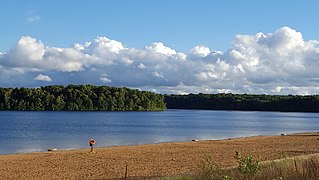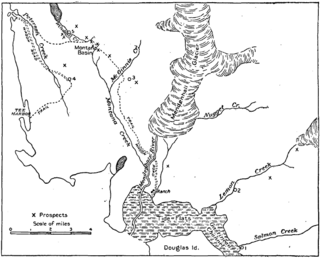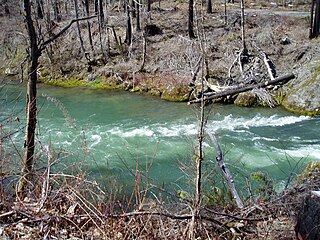| Eagle River | |
|---|---|
| Country | United States |
| State | Alaska |
| Municipality | Juneau |
| Physical characteristics | |
| Source | Eagle Glacier |
| - location | Coast Mountains, Tongass National Forest |
| - coordinates | 58°35′16″N134°43′26″W / 58.58778°N 134.72389°W [1] |
| - elevation | 994 ft (303 m) [2] |
| River mouth | Favorite Channel |
| - location | 20 miles (32 km) northwest of downtown Juneau |
| - coordinates | 58°31′37″N134°49′18″W / 58.52694°N 134.82167°W Coordinates: 58°31′37″N134°49′18″W / 58.52694°N 134.82167°W [1] |
| - elevation | 0 ft (0 m) [1] |
| Length | 5 mi (8.0 km) [1] |
The Eagle River is a stream, 5 miles (8 km) long, in the borough of Juneau in the U.S. state of Alaska. [1] Heading at Eagle Glacier in the Coast Mountains, it flows southwest into Favorite Channel, 20 miles (32 km) northeast of the city of Juneau. [1] Alaska Route 7 (Glacier Highway) links the city to the river, a state recreation area, a church camp, and a boy scout camp near the river mouth.

The City and Borough of Juneau, commonly known as Juneau, is the capital city of Alaska. It is a unified municipality on Gastineau Channel in the Alaskan panhandle, and it is the second largest city in the United States by area. Juneau has been the capital of Alaska since 1906, when the government of what was the District of Alaska was moved from Sitka as dictated by the U.S. Congress in 1900. The municipality unified on July 1, 1970, when the city of Juneau merged with the city of Douglas and the surrounding Greater Juneau Borough to form the current municipality, which is larger by area than both Rhode Island and Delaware.

In the United States, a state is a constituent political entity, of which there are currently 50. Bound together in a political union, each state holds governmental jurisdiction over a separate and defined geographic territory and shares its sovereignty with the federal government. Due to this shared sovereignty, Americans are citizens both of the federal republic and of the state in which they reside. State citizenship and residency are flexible, and no government approval is required to move between states, except for persons restricted by certain types of court orders. Four states use the term commonwealth rather than state in their full official names.

Alaska is a U.S. state in the northwest extremity of North America, just across the Bering Strait from Asia. The Canadian province of British Columbia and territory of Yukon border the state to the east and southeast, its most extreme western part is Attu Island, and it has a maritime border with Russia to the west across the Bering Strait. To the north are the Chukchi and Beaufort seas—southern parts of the Arctic Ocean. The Pacific Ocean lies to the south and southwest. It is the largest U.S. state by area and the seventh largest subnational division in the world. In addition, it is the 3rd least populous and the most sparsely populated of the 50 United States; nevertheless, it is by far the most populous territory located mostly north of the 60th parallel in North America: its population—estimated at 738,432 by the United States Census Bureau in 2015— is more than quadruple the combined populations of Northern Canada and Greenland. Approximately half of Alaska's residents live within the Anchorage metropolitan area. Alaska's economy is dominated by the fishing, natural gas, and oil industries, resources which it has in abundance. Military bases and tourism are also a significant part of the economy.
Contents
Hiking trails parallel the river for its entire course. One, the Amalga Trail, leads to a public-use cabin on a lake near the foot of Eagle Glacier in the Tongass National Forest. Remnants of the forming mining town of Amalga and the Eagle Creek Mine are slightly north of the river along an unnamed tributary.

The Tongass National Forest in Southeast Alaska is the largest national forest in the United States at 16.7 million acres (68,000 km2). Most of its area is part of the temperate rain forest WWF ecoregion, itself part of the larger Pacific temperate rain forest WWF ecoregion, and is remote enough to be home to many species of endangered and rare flora and fauna. The Tongass, which is managed by the United States Forest Service, encompasses islands of the Alexander Archipelago, fjords and glaciers, and peaks of the Coast Mountains. An international border with Canada runs along the crest of the Boundary Ranges of the Coast Mountains. The forest is administered from Forest Service offices in Ketchikan. There are local ranger district offices located in Craig, Hoonah, Juneau, Ketchikan, Petersburg, Sitka, Thorne Bay, Wrangell, and Yakutat.







